
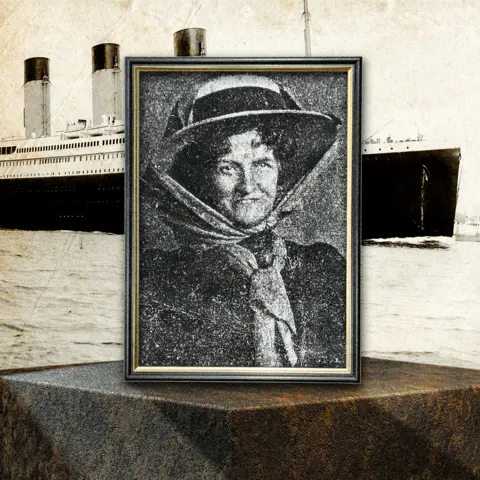 BBC
BBCA fashionable crocodile bag and small perfume vials that still give off an intense scent are just some of the precious finds recovered from the most famous wreck in the world: the Titanic.
The exact location of the warehouse where they are stored is a closely guarded secret, due to the value of its contents. All we can say is that it is located somewhere in Atlanta, Georgia, USA.
Inside, shelves are filled with thousands of objects: from an upturned bathtub to a dented porthole, to intricately engraved glasses and tiny buttons.
The BBC was given the rare opportunity to take a look inside the vault and uncover the hidden stories behind some of these objects.

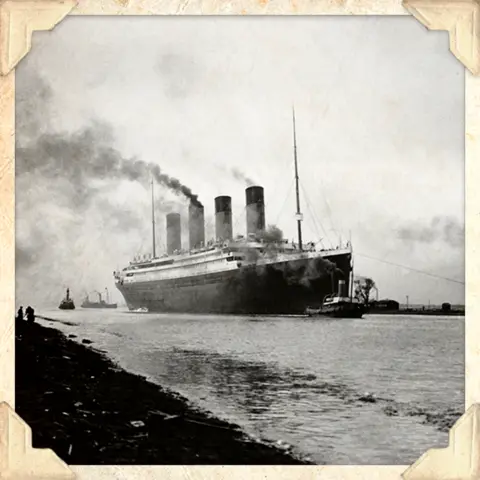
A crocodile bag that hides a tragic story
“It’s a really cool, fashionable handbag,” says Tomasina Ray, director of collections for RMS Titanic Inc., the company that recovered the artifacts. The U.S. company holds the rights to salvage the ship and has recovered 5,500 items from the wreck site over the years, a selection of which is on display around the world.
The bag is made of alligator skin, which has survived for decades in the depths of the North Atlantic. The delicate objects inside have also been preserved, revealing details of its owner’s life – a third-class passenger named Marian Meanwell.
“She was a 63-year-old milliner,” Tomasina says. “And she was traveling to the United States to be with her daughter who had recently been widowed.”
Among the mementos inside was a faded photograph, thought to be of Marian Meanwell’s mother.

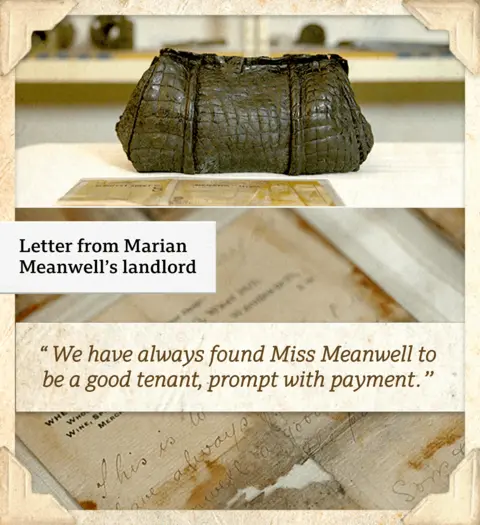
There were also documents she would need for her new life in America, including a handwritten letter of reference from her former landlord in London. It read: “We have always found Miss Meanwell a good lodger, punctual in her payments.”
His medical inspection card was also in there, since all third-class passengers had to prove they had not brought any diseases into the United States. But this water-stained document reveals a tragic twist of fate.
Marian Meanwell was booked on the Majestic, another White Star Line ship. But she never sailed, so on the chart, the Majestic is crossed out and her passage shows that she was transferred to the Titanic and became one of the 1,500 people who lost their lives.
“Being able to tell his story and having these objects is really important,” says Tomasina.
“Otherwise it’s just another name on the list.”
A perfume that still has an impact
Items belonging to survivors were also brought back from the depths.
Tomasina opens a plastic container and a sickly sweet smell fills the air. “It’s very powerful,” she admits.
Inside are small vials of perfume. They are sealed, but their strong aroma escapes, even after decades on the seabed.
“There was a perfume salesman on board and he had more than 90 of these little vials of perfume,” Tomasina explains.
His name was Adolphe Saalfeld and he was travelling as a second class passenger.

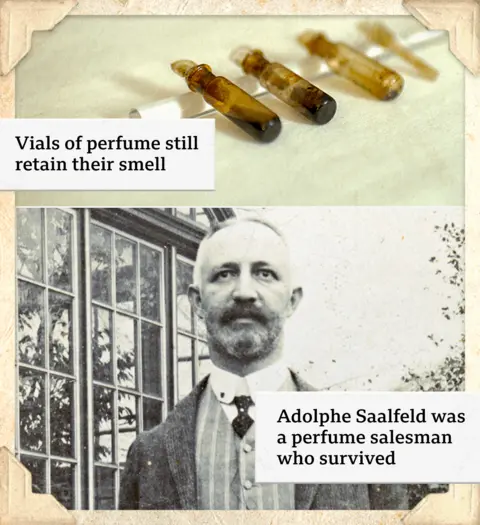
Saalfeld was one of 700 people who survived. But with women and children being the priority during the evacuation, some of the men who managed to leave the ship were troubled.
“He was already dead when we found this,” Tomasina says. “But I realized he was living with a little bit of guilt, survivor’s guilt.”


A champagne lifestyle
The collection also includes a bottle of champagne, complete with champagne inside and a cork stopper.
“Some water would probably have gotten in through the cork as it compressed and equalized the pressure. And then it just sat on the ocean floor,” Tomasina says.
When the Titanic sank in 1912 after hitting an iceberg, the ship split apart and its contents spilled out, creating a vast field of debris.

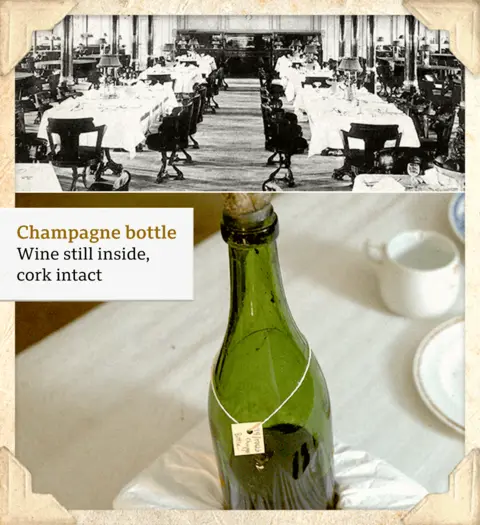
“There are a lot of bottles on the ocean floor and also a lot of pots and pans from the kitchen, because the Titanic actually broke up right next to one of the kitchens,” Tomasina says.
There were thousands of bottles of champagne on board. The owner of the ocean liner wanted his first-class passengers to experience the height of opulence, with sumptuous surroundings and the finest food and drink.

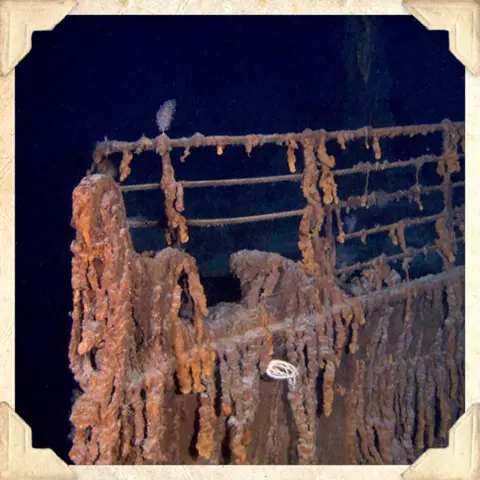
“It was like a floating palace and the Titanic was supposed to be the most luxurious ship,” Tomasina says.
“So having champagne, having a gym, having all these amenities and these great things for the passengers would have been really important to them.”

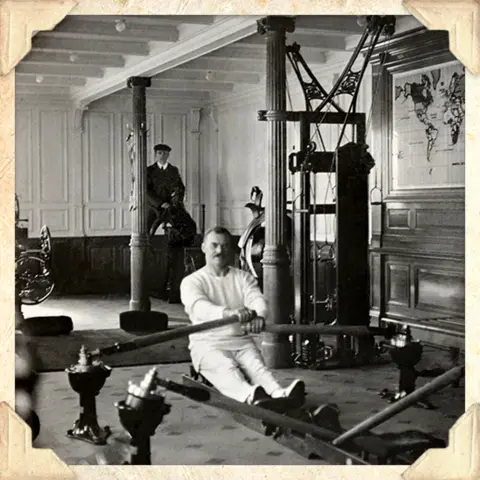
Rivet Revelation
The Titanic was on its maiden voyage, from Southampton to the United States, when it struck the iceberg.
The ship was equipped with state-of-the-art safety measures for its time and was said to be unsinkable.
Tomasina shows us some of the ship’s rivets, sturdy metal pins that held together its thick steel plates. There must have been more than three million of them.
“When the Titanic sank, there was a theory that maybe poor materials had been used, and that made it sink faster,” Tomasina explains.


Some of these rivets have been tested to see if they contain impurities.
“There were high concentrations of slag in these, which is a glass-like material that makes them perhaps a little more brittle in the cold,” he says.
“If these rivets were brittle and one of the heads came off more easily, then the seam could open up where the iceberg hit, becoming larger than it otherwise would be.”
Tomasina says there is still much to be discovered about the exact manner in which the ship sank.
“We can help analyze the theories, so we’re very happy to be able to contribute to the science and history behind it.”


The class divide
Life on board was different depending on social class, even down to the cups and plates from which one drank and ate.
A third-class white cup is simple and sturdy, with a bright red White Star logo. A second-class plate has a pretty blue floral decoration and looks a little more refined. But a first-class serving dish is made of more delicate porcelain. It has a gold finish, and under the light you can see an intricate garland pattern.
“That pattern would have been colored, but because it was colored over the glaze, it was able to wash off,” Tomasina says.
The more affluent passengers in first class were served a silver service for their meals, but in third class it was a different story.
“Third-class passengers would probably have handled the porcelain themselves: it was certainly designed to be much more stable and much easier to handle than other porcelains,” explains Tomasina.

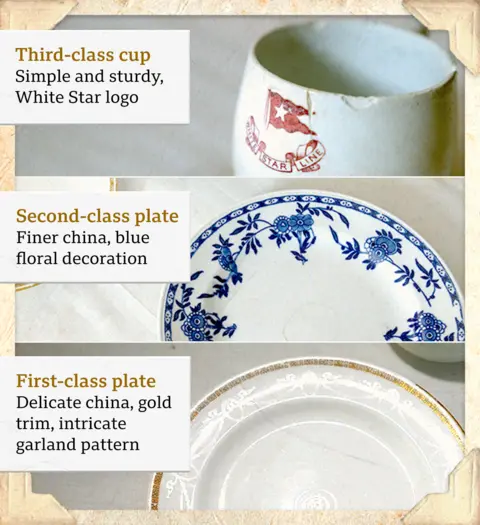
RMS Titanic Inc is the only company legally allowed to recover items from the site: it was granted the right by a US court in 1994. But it has to do so under strict conditions: the items must always remain together, so they cannot be sold separately, and they must be properly stored.
So far, all the artifacts have been collected from the debris field. But the company recently sparked controversy by declaring its desire to recover one item from the ship itself: the Marconi radio equipment that transmitted the Titanic’s distress calls the night she sank.


Some believe the wreck is a burial site and should be left there.
“Titanic is something we want to respect,” Tomasina replies.
“We want to make sure that we preserve the memory, because not everyone can go on the Titanic, and we want to be able to make that public.”
More shelf space may soon be needed in this secret warehouse.
The company’s latest expedition to the site involved capturing millions of images of the wreck to create a detailed 3D scan.
In addition to examining the current condition of the Marconi radio room, the team also identified objects in the debris field that they would like to recover on future dives.
Who knows what they will find and what untold stories each object will reveal about the ill-fated Titanic and its passengers.
Photo credits: Marian Meanwell: Patricia Chopra / Titanic Encyclopedia; Adolphe Saalfeld: Astra Burka Archives; Titanic Wreck: RMS Titanic Inc; Titanic Artifacts: Kevin Church / BBC; Historical Images: Getty Images.
Designed by Lilly Huynh





